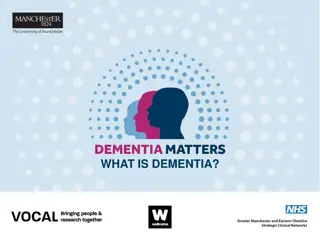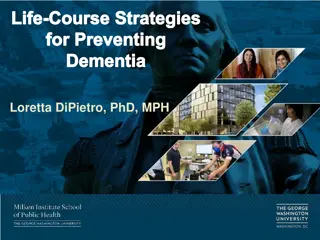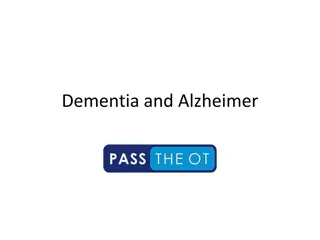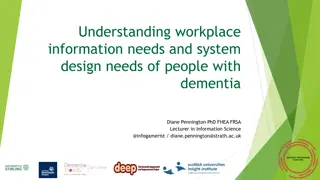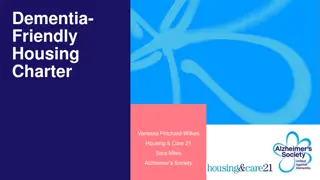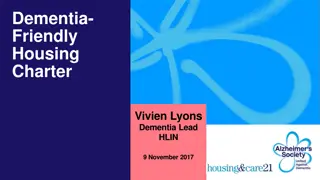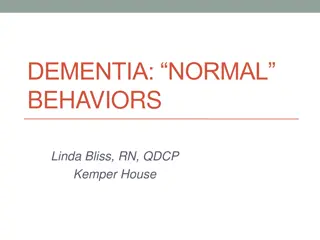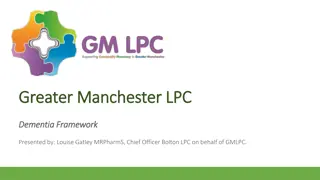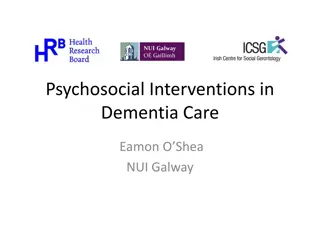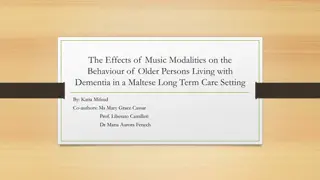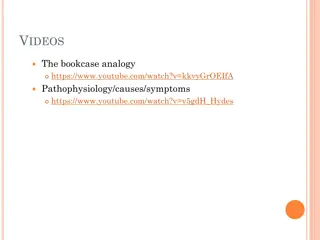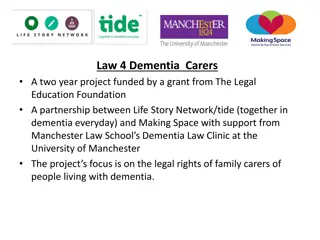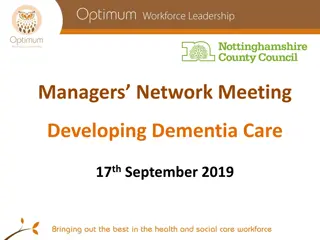Understanding Dementia: A Comprehensive Overview by Dr. Fiona McDowall
Dementia, as explained by Dr. Fiona McDowall, is a complex decline in cognitive function affecting memory, behavior, and various higher brain functions. The demographics show a concerning rise in the elderly population affected by dementia globally. The types and clinical features of dementia highlight the challenges faced by individuals and caregivers dealing with memory loss and cognitive impairments, particularly in Alzheimer's disease. Understanding these aspects is crucial for early diagnosis and appropriate management.
Download Presentation

Please find below an Image/Link to download the presentation.
The content on the website is provided AS IS for your information and personal use only. It may not be sold, licensed, or shared on other websites without obtaining consent from the author. Download presentation by click this link. If you encounter any issues during the download, it is possible that the publisher has removed the file from their server.
E N D
Presentation Transcript
DEMENTIA AND DELIRIUM Dr Fiona McDowall. Consultant old age psychiatrist
DEMENTIAS What is dementia Demographics Clinical features Types of dementia Pathology Diagnosis Treatment
What is dementia Dementia is a clinical term describing a symptom complex characterised by a decline from previously maintained intellectual function It occurs in clear consciousness Decline affects more than one higher cortical function Affects memory, behaviour, personality, judgment, attention, spatial relations, language, abstract thought, other executive functions such as planning and social judgement
Demographics >65 population has increased x4 since start of century 18% of the population now > 65 years old Dementia affects 5% of those > 65 20% of those > 80 Currently the leading cause of death in UK Globally rise to 132 million by 2050
Types of dementia Alzheimer s Disease Vascular dementia Mixed dementia Dementia with Lewy Bodies Fronto-temporal Dementia
Clinical features of dementia 1.Loss of memory and higher brain functions such as planning, decision making, problem solving 2.Impairment of Activities of Daily Living (ADLs) Washing, dressing, cooking, telephone, TV, money, getting lost, driving, appliances. 3.Behavioural and Psychological Symptoms (BPSD)
Memory loss in dementia Types of memory 1) Short-term - frontal lobes, tested by immediate recall of words or digit span 2) Long-term memory - limbic system, t. neocortex Episodic - personally experienced, temporal -specific Semantic - general knowledge and factual Information-procedural - learnt tasks
Memory loss in Alzheimers disease Temporal gradient of forgetting Shrinking repertoire of memories Difficulty learning new information Short term memory loss >long term
Temporal lobe and dementia Episodic memory - Limbic system -Semantic memory - Temporal neocortex -Dominant hemisphere - Verbal memory -Wernicke s dysphasia - Language comprehension -Non-dominant hemisphere - Visual memory -Activities of daily living -Forgetting appointments, medication/repetition -Living in the past - reminiscing -Confabulation -Non-recognition of familiar surroundings
Parietal lobe and dementia Functions relevant to dementia symptoms Dominant hemisphere: Writing/Calculation R-L orientation Non-Dominant: Visuospatial perception Location in space Apraxia - inability to carry out a task in absence of motor or sensory loss Agnosia - inability to recognise, despite normal perception e.g. using money, driving, telephoning, getting dressed, eating, going to the toilet, making a cup of tea
Frontal lobe and dementia Working memory Functions relevant to dementia Controls executive functions i.e. organising, planning, problem solving, sequencing, adapting and learning new tasks Personality, especially motivation Regulation of social behaviour / initiative Motor speech: Broca s area Cortical inhibition of bowels and bladder
Clinical features of dementia Misidentification 30% Persecution, theft 16% Delusions - Visual 13% -Auditory 10% Hallucinations Depression 20% Challenging behaviour (BPSD) - Aggression, Wandering, Agitation, restlessness, sundowning
Risk assessment and dementia Wandering Neglect Fire Financial exploitation Aggression Driving
Pathology and dementia Global cortical atrophy Medial temporal atrophy(hippocampus) Vascular changes Infarcts Neurofibrillary tangles, amyloid plaques Neuronal loss and cholinergic deficits(acetyl cholinesterase inhibitors)
Risks and protective factors Risks: Age, genetics, Down s syndrome, life style, vascular risks, female, head injury. Protective: company, IQ, cognitive stimulation, learning new things, life style and diet, decrease the vascular risks.
Making a diagnosis History. COLLATERAL very important which type of memory loss, examples Speech / language difficulties Orientation difficulties Onset / course of deterioration Personality change/ risk/challenging behaviour _ADLs FH Positive? PH educational level/ occupational attainment Med Hx SHx
Making a diagnosis Mental state examination: Depression, hallucinations, delusions. Cognitive assessment: ACE-III, Mini-ACE Cognitive decline in at least two domains(memory, language, orientation, visuospatial, fluency) for at least 6 months AND decline with function (ADLS)
Investigations Brain scans Bloods: full confusion screen FBC, ESR/CRP, Us and Es, LFTs, Ca, B12, folate, TFTs, glucose.
Treatment Medication: acetyl cholinesterase inhibitors, memantine, antidepressants, antipsychotics. Psychological Social Supporting organisations: social care, Alzheimer s society, carers, home care. LPA, Advance care plans, driving, will.
Dementia and the general hospital 1/4 patients in the acute hospital have a diagnosis of dementia 1/3 in acute hospital have delirium 1/3 patients on an acute take are in the last year of life Diagnostic overshadowing Dementia/delirium/depression overlap
Delirium Definition Diagnosis Investigations Treatment
Delirium definition Delirium (acute confusional state) is a neuropsychiatric syndrome characterised by acute onset of fluctuating cognition and inattention linked to triggering factors. It usually develops over 1-2 days. Delirium is a serious condition that may be associated with poor outcomes. However it can be prevented and symptoms treated if identified early
Delirium definition The American Psychiatric Association s Diagnostic and Statistical Manual, 4thEdition (DSM-IV) defines delirium by the presence of 4 key clinical features: Disturbance in consciousness with reduced ability to maintain or focus attention A change in cognition or development of a perceptual disturbance which is not better explained by a pre- existing dementia. Acute onset and fluctuating course. Evidence of a triggering medical condition or causative substance.
Delirium definition Symptoms of delirium have a tendency to fluctuate throughout the course of a day, and as such is frequently under recognised. Delirium presents in one of three ways: Hyperactive delirium: restless, agitated, delusions, hallucinations, risk of harm to patient or others. Hypoactive delirium: lethargic, drowsy, reduced communication. Mixed Delirium: demonstrates signs of both of the above. Hypoactive and mixed delirium may be more difficult to recognise.
Delirium demographics Delirium is common in hospital affecting: 30% of older medical patients at some point during a hospital admission. 10-50% of patients post operatively. 70-80% of patients in an ITU setting 20% of patients in post-acute care settings
Delirium demographics Despite its frequency delirium is under recognised in hospitals. Delirium should be considered a medical emergency and is associated with unfavourable outcomes including: Increased mortality in older people (35-40% at 1 year) Increased length of stay. Increased rates of placement in care home. Increased risk of in-hospital complication such as pressure ulcers and falls. In addition to the above up to 60% of older patients with delirium have persisting cognitive impairment and will go on to receive a diagnosis of dementia.
Delirium demographics Delirium is preventable in up to 1/3rdof cases and is treatable if identified and managed appropriately and urgently. As such it should be considered a medical emergency.
Delirium differential diagnosis Diagnoses that may be difficult to distinguish from delirium are dementia, depression, psychotic illness, dysphasia, mania and non-convulsive epilepsy. It can be difficult to distinguish between dementia and delirium because symptoms overlap and some patients may have both conditions. Dementia is associated with progressive decline and is irreversible. Delirium is associated with a fluctuating course and may be reversible. If clinical uncertainty exists over diagnosis then initial management should be for delirium.
Delirium risk factors Age 65 years or older Current hip fracture Cognitive impairment or dementia Severe illness
Delirium risk factors Co-morbidities Current hip fracture, clinical frailty, multiple co-morbid conditions, chronic renal or hepatic impairment, history of stroke or other brain injury, dehydration, malnutrition, severe illness Existing dementia, past history of delirium, depression Cognitive status Demographics 65 years +
Delirium risk factors Drugs Polypharmacy (>3 drugs), psychoactive drugs, alcohol or other recreational drug use Immobility, dependant ADLS, history of falls Functional status Sensory impairment Visual or hearing loss
Delirium diagnosis and assessment It may not be possible to obtain a history from the patient although reasonable attempts should be made. A collateral history should be sought which in addition to standard questions should include the following: Previous cognitive function Previous episodes of delirium Functional status Sensory deficit Usual communication method Symptoms suggestive of underlying cause Drug history including alcohol History
Delirium diagnosis and assessment Physical examination A full clinical examination should be carried out and should include: Neurological examination Rectal examination Glasgow Coma Scale (GCS) Pain assessment (Abbey pain score) Assessment of pressure areas Nutritional assessment (MUST)
Delirium diagnostic tools Confusion Assessment Method (CAM) The diagnosis of delirium requires the presence of point 1 and 2 and either 3 or 4: Acute onset and fluctuating course Inattention (inability to concentrate) Disorganised thinking (rambling, illogical ideas) Altered level of consciousness (hyper alert or drowsy) The CAM has a sensitivity of 94-100% and specificity of 90- 95% when applied by a person competent in identifying delirium.
Delirium diagnostic tools 4A Test (4AT) Patients are scored on 4 categories: Alertness: Normal =0 Mild sleepiness = 0 Clearly abnormal = 4 AMT4 (age, place, building, DOB): No error = 0 1 error = 1 2 or more error = 2 Attention (list months of the year backwards): 7 months or more = 0 starts but less than 7 months = 1 Untestable/doesn t start = 2 Acute change or fluctuating course: No = 0 Yes = 4 A score of 4 or above indicates delirium +/- cognitive impairment, 1-3 indicates cognitive impairment, 0 suggests cognitive impairment/delirium unlikely. The 4AT is less subjective than the CAM and does not require special training. It also allows screening of untestable patients (those who cannot undergo cognitive testing or interview because of severe drowsiness or agitation). The 4AT has a sensitivity of 89.7% and a specificity of 84.1% in the detection of delirium.
Delirium precipitating factors/causes Environment Change in environment Loss of visual or hearing aid Inappropriate noise or lighting Immobility Poor sleep hygiene Catheters and drips Falls Physical restraint. Fluid and electrolyte abnormality Hypo/hypernatremia Hyper/hypocalcaemia AKI Dehydration Neurological illness Stroke Seizure Intracerebral bleeds Respiratory/cardiovascular Hypoxia of any cause Myocardial infarction Alcohol or sedative withdrawal Sedative hypnotics Opioids Anti-parkinsonian medications Antidepressants Anticonvulsants Steroids Anticholinergic medication Drugs
Delirium precipitating factors Infections Surgery Urinary and faecal retention Metabolic Of any cause Hypo/hyperthyroidism Hypo/hyperglycaemia Liver failure B12/folate/thiamine deficiency Pain
Delirium precipitating factors A memory aid for delirium precipitants-think DELIRIUM Drugs (withdrawal, toxicity)/Dehydration Electrolyte imbalance Level of pain Infection/Inflammation (post op) Respiratory failure Impaction of faeces Urinary retention Metabolic disorder (liver/renal failure, hypoglycaemia) Myocardial infarction NB in 30% of cases no cause found.
Delirium investigations The following are almost always indicated in investigation of acute confusion in order to identify an underlying cause: FBC U&E Calcium B12 and Folate TSH Glucose ECG Urine analysis. CT/MRI brain Arterial blood gases Blood cultures EEG LP
Delirium non pharmacological treatment Do s Don ts Correct hypoxia Remain vigilant for infection Correct dehydration Involve dieticians Treat pain and use not verbal scoring systems Involve family in care Document well Involve mental health teams if psychotic symptoms present Ensure patient is observed at arms length and consider extra staffing Engage patient in meaningful activities Repeated orientation Ensure patient has sensory aids Ensure good lighting levels in the day. Use non-confrontational and empathic de-escalation techniques Delay diagnosis Catheterise unnecessarily Use IV lines unnecessarily Order unnecessary tests Disturb sleep for obs/medication rounds Subject patient to unnecessary bay or ward moves Turn lights on unnecessarily at night Use medication unless other interventions have failed. Use high doses of medications for elderly patients.
Delirium pharmacological treatment NICE 2010: haloperidol or olanzapine in low doses for 1 week or less. Use antipsychotics with caution in Parkinson s or dementia in Lewy body. Lorazepam, promethazine, risperidone. procyclidine
Differentiating dementia and delirium Dementia Delirium Chronic slow decline acute onset hrs/days Functional decline previously functional Clear consciousness impaired Non reversible reversible Usually non fluctuant fluctuates Both may present with delusions and hallucinations
Clinical scenarios Winston Churchill 1874-1965 History documented by Lord Moran ?Very early symptoms 1944 Decrease in concentration, quarrelsome and irritable, argued with key allies 1949 CVA Right hand and arm weakness, good physical recovery, no publicity 1950/1951 2 TIAs 1951 Returned as PM, deterioration evident in mental functioning, documents were condensed to a single paragraph, poor memory for world events 1953 CVA during a state banquet. Good physical recovery, speeches rehearsed many times 1954 Confused over names and places 1955 Resigned 1965 Died immobile, with severe dementia
Clinical scenarios Al is a 76- year-old male, who has been in the hospital for one day. Al has not had any unusual behaviours, but his family reports that slowly over the course of the past year, he has been getting gradually more forgetful. Al has more trouble dressing than he did last year. Al seems to have more trouble finding the right words to say than he did a year ago. Al gets confused more often than last year about where he is going. None of these changes happened all at once, but Al seems to be slowly getting more confused in his memory and thinking. Vital signs, physical examination and ECG have been normal, and all lab values were within normal limits.
Clinical scenarios Betty is an 80-year-old female who has been the hospital for two days. Betty has been doing fine, and has no memory complaints. One morning, Betty does not want to get out of bed. Betty does not seem to be interested in food and seems very slowed down. She appears sleepier than usual, and is disoriented to time, place, and mistakes her nurse for one of her relatives. Betty does not seem to be paying much attention when you talk to her. Over the next few days, Betty spends a lot of time just lying in bed and staring into space. According to the family, she did not have a history of depression, sadness, or feeling blue.
Clinical scenarios Diane is an 83-year-old female who has been in the hospital one day. According to her family, Diane has had increasing memory problems over the past year, and problems getting lost while driving to a local restaurant where she has been many times. She has more difficulty finding the right name for things. She has also experienced increased difficulty in completing daily ADL s. In the morning, you go in to check her vital signs and suddenly she is more confused. She tells you to stay away and tries to punch you. This is not her usual behaviour at home. She accuses you of trying to kill her and steal her belongings. She is disoriented to time and place, and does not recognize you as her nurse. You leave the room, and you hear her talking to herself and moving things around in the room. You return to check on her and find that she has pulled out her IV.
Questions?? fionamcdowall@nhs.net


